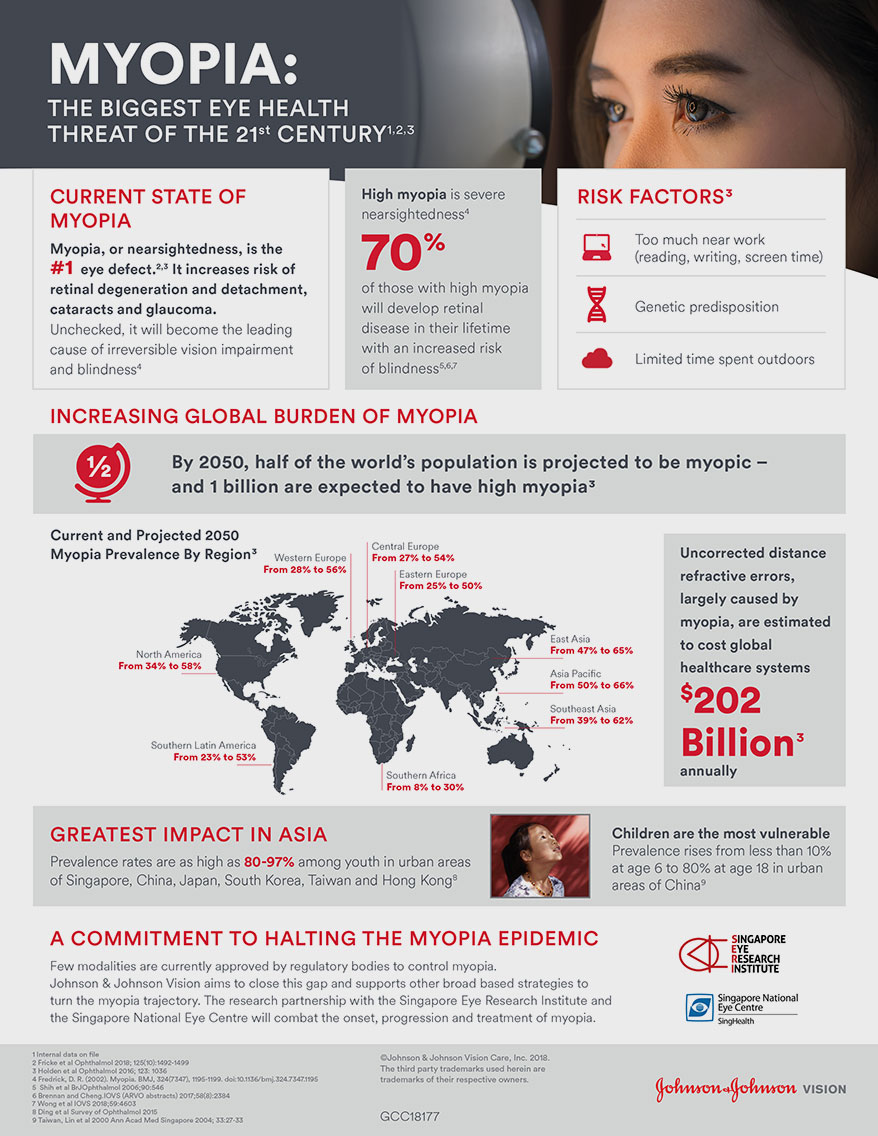(PRESS RELEASE) SINGAPORE – The Singapore National Eye Center (SNEC), the Singapore Eye Research Institute (SERI) and Johnson & Johnson Vision announced a US$26.35 million (S$36.35 million) research collaboration to tackle myopia, or nearsighted vision, the largest threat to eye health this century. By 2050, half of the world’s population are projected to be myopic, with one billion expected to have high myopia, a severe state of the condition that can lead to retinal disease with an increased risk of blindness.
The first-of-its-kind public-private strategic partnership in Asia focused on myopia will create a deeper understanding of how the condition develops, how it progresses and how it may be intercepted. It will focus on developing predictive tools to identify those who may be at risk to develop high myopia, conduct research on the underlying mechanisms of myopia, progress novel therapies, and discover and validate methods to prevent the onset and progression of the condition.
“The incidence of myopia is increasing at an alarming rate around the world and if left unchecked, the human and financial toll could skyrocket in the coming decades, especially in Asia,” said Paul Stoffels, M.D., vice chairman of the Executive Committee and Chief Scientific Officer, Johnson & Johnson.
“We are delighted to be collaborating with SERI and SNEC to better understand the underpinnings of this condition and identify ways to halt this global public health threat,” he said. “Together, we hope to bring important progress to individuals and families throughout the Asia Pacific region and ultimately, around the world.”
“Documented increases in myopia, especially among young people, are a serious concern and if we can understand the underlying mechanisms that are contributing to its rapid rise, we can work to tackle the problem at its roots,” said Professor Aung Tin, executive director of SERI. “SERI is strongly committed to collaborating with leading companies to address eye diseases, and we are excited to be embarking on this research collaboration to break new ground against the epidemic.”
According to Professor Wong Tien Yin, Medical Director at the SNEC, the collaboration will bring together the right mix of resources, clinical and scientific experience, and intellect to create a leading centre for myopia research, clinical care and education practices designed to contribute substantially to regional and global efforts to fight the condition. “SNEC is honored to be working with collaborators coming together to address the growing burden of myopia,” Professor Wong said. “By leveraging the diverse strengths of our clinicians, clinician scientists and strategic partners to establish new disease frameworks and share this knowledge across world communities to help eradicate myopia.”
Advertisement
Myopia is the number one eye defect in the world.1,2 Myopia increases risk of retinal degeneration and detachment, cataracts and glaucoma. Unchecked, it will become the leading cause of irreversible vision impairment and blindness.1 The condition occurs when the eyeball becomes elongated due to environmental and genetic factors. Few modalities are currently approved by regulatory bodies to control myopia.
Significant Burden Projected Worldwide, With Biggest Impact in Asia
- Five billion people globally are expected to have myopia by 2050.1
- East Asia and Singapore will shoulder the greatest impact, with current prevalence rates among young people as high as 80 to 97 percent concentrated in urban areas.
- Children are most vulnerable. For example, in China, among children ages six to 18, myopia prevalence rises from less than 10 to 80 percent. Children who go on to develop high myopia are at a high risk for a lifetime of severe eye disease and permanent vision loss.
- In Singapore, one in two children develop myopia by the age of 12, and 75 percent of teenagers are myopic and rely on glasses.
- Uncorrected distance refractive errors, largely caused by myopia, are already estimated to cost global healthcare systems US$202 billion annually1 and this cost will rise exponentially with increased prevalence and severity of myopia in coming decades.
- In Singapore alone, the annual direct cost of optical correction of myopia for Singaporeans has been estimated at US$755 million (S$1.04 billion).
Due to the complexity and scale of myopia, halting the epidemic will require a multidisciplinary approach that encompasses novel clinical research as well as innovations in education and clinical care. SNEC, SERI and Johnson & Johnson Vision intend to build on these efforts and convene other stakeholders to support broad-based strategies.
Johnson & Johnson Vision brings to this initiative deep expertise in optometry and ophthalmology backed by the strength, capabilities and reach of the Johnson & Johnson Family of Companies, which are committed to solving complex global public health challenges. SERI and SNEC have a strong track record of high-impact eye research and excellence in clinical care that has paved the way for improvements in how eye diseases are detected, prevented and treated in Singapore, across Asia and on a global scale.
